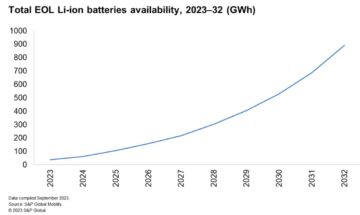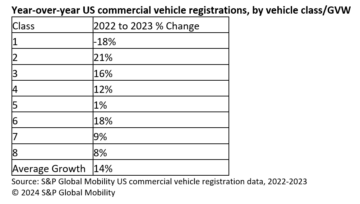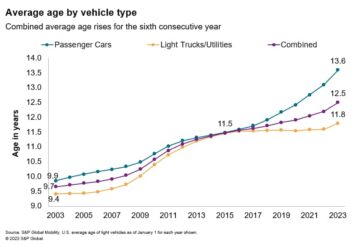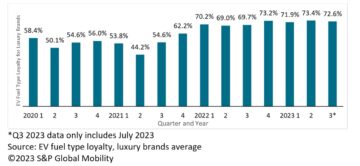Automotive Monthly Newsletter and Podcast
This month’s theme: The New Map – Charting the Future
Now in its 39th year, IHS Markit’s CERAWeek is widely considered
to be the most prestigious annual gathering of CEOs and ministers
from global energy and utilities, as well as automotive,
manufacturing, policy, and financial communities, along with a
growing presence of technology. This year’s central theme was
focused around how dramatic shifts in energy and geopolitics shape
a new global map. This map is defined less by physical and
political boundaries than by alterations, integrations, and
possible collisions in global business and government.
Mobility Transition
From several mobility related panel discussions, we learned that
the 2021 mobility market (car sharing and ride hailing) sentiment
is much more positive as demand is starting to gradually return to
pre-pandemic levels. Although public transit is expected to
continue lagging behind – particularly in terms of passenger
kilometres – the personally owned car is still perceived as one of
the safest mobility options for the time being. Lyft also suggested
that robotaxi/autonomous vehicle technology will clearly represent
a future growth driver but admitted that this is still a few years
away. In the interim, Lyft remains excited about the growth
opportunity for micromobility, which has grown further since the
pandemic (especially for e-bikes). The world has also seen renewed
climate targets/net-zero emissions ambition (such as GM’s 100% ZEV
self-mandate) for which the mobility service providers are among
the first to potentially realise the opportunity. According to some
of the leading mobility service providers, ‘shared vehicles’ can
help with cost management as well as energy management as a shared
EV vehicle could achieve energy savings of up to 50% per mile.
Especially as mobility could be defined in its essence as ‘moving
people from one place to another using energy’, hence the sharing
aspect could also unlock lower numbers of vehicles on the roads.
This would be a welcome step towards the mobility transition as the
affordability of owning a car is increasingly being
challenged.
Another element on the map towards the mobility transition was
expected to be a move to ‘human centred’ cities. Effectively the
pandemic has kickstarted this trend with many cities around the
world starting to close off streets to traffic and reserve it for
bikes/walking instead; while the rise of the so-called ‘parklets’
(parking spaces transformed into a community space) might lead to
lost parking revenue for cities, they do open up other economic
opportunities. Lyft argued that cities belong to people first and
cars second, and that this transition has now started in earnest,
and hopes to soon see the creation of ‘mobility lanes’ so future
cities will truly be reinvented and shared mobility could become a
focal point.
We also heard from several stakeholders in the vehicle powertrain
sector that the overall future propulsion system value proposition
effectively depends on the vehicle application, and that
consequently there will be room for fuel-cell electric vehicle
(FCEV) and battery-electric vehicle (BEV) systems in the light
vehicle market and beyond. Leading charging infrastructure
providers also debated that the overall energy equation (energy
source, location, availability) is ultimately the key to providing
charging solutions for local markets.

Regulatory/Finance Transition
We learned from Bill Gates that the ‘net-zero emissions’ goal is
increasingly gaining political support, but that much more work
still needs to be done. Gates also claimed that when looking back
in history, things have never changed so fast as we need them now
to change, meaning this will be an extremely tough transition to
achieve by 2050 (and effectively impossible by 2030). From a
technology perspective, dozens of breakthroughs are needed, while
at the same time innovation needs to be available for the entire
world – otherwise the emerging markets will not be able to achieve
this by 2050. According to Gates, in the next 30 years we need the
electric grid to triple in size while staying reliable and
affordable – a difficult task compared to all the electrification
we have achieved so far. Hence, Gates sees a key role for
governments here, and they need to start planning ahead.
Energy Secretary Jennifer Granholm displayed much enthusiasm
when she claimed that the net-zero economy by 2050 can also be seen
as a great economic opportunity, which she believes to be worth up
to USD23 trillion. She went on to pledge full support for the US
electric vehicle and battery sector, mentioning government
focus/support for improving battery energy density, building local
critical mineral supply chains, and establishing a battery
recycling sector.
Mark Carney, the former governor of the Bank of Canada/England
and the current UN Special Envoy for Climate Action and Finance,
stressed that there is a need for credible national climate
policies to help provide predictability and commitment from
industry sectors to invest in the future.

Industry & Supply Chain Transition
Large industrial stakeholders such as ThyssenKrupp Steel
reminded us that decarbonising industries is a wider system problem
and needs to be treated as such. Hence one cannot look at it in
isolation from a particular stakeholder but as a systems approach,
so one needs to look at the wider picture as decarbonisation
affects the entire value chain. This view is supported by Amazon
Web Services (AWS), which agreed that the transition will not be
easy and that there has to be cooperation with others
(companies/countries/sectors) if you want a chance to succeed. A
view echoed by energy giant BP’s CEO who alluded to the fact that
BP is effectively morphing into a ‘mobility integrated’ company now
that it realises that it is part of a wider ecosystem that needs to
change. DOW Automotive shared that, from its perspective, advanced
materials should be embraced as enablers for the transition and
cooperation with OEMs could unlock new material properties that
could help vehicle components to perform for the lifetime of a
vehicle, providing increased levels of sustainability. In other
words, the automotive tier supplier community also needs to
transform and could reposition itself as a key partner/enabler for
the OEM and the wider mobility ecosystem.
Further calls for partnerships were heard but one of them stood
out as the technology sector’s CAVNUE pleaded for more cooperation
across sectors via so-called public-private partnerships (PPP); and
made a strong case for an optimised single technology platform of “digitised roadways” providing autonomous vehicle-enabled
future-proof roads in the name of safe autonomous vehicles on every
road, which could presumably help vehicles to unlock improved
energy efficiency as well.
Dive Deeper – Check out our CERAWeek videos…
CERAWeek Video – The Future of the
Digital World
CERAWeek Video – The New Map:
Energy, Climate, and the Clash of Nations
CERAWeek Video – EV Charging
Infrastructure: Navigating COVID-19 & planning for post-crisis
demand
Source: http://ihsmarkit.com/research-analysis/fuel-for-thought-the-new-map–charting-the-future.html
- &
- 2021
- Action
- advisory
- All
- Amazon
- among
- Application
- around
- automotive
- autonomous
- autonomous vehicles
- availability
- AWS
- Bank
- battery
- Bill
- Bill Gates
- BP
- Building
- business
- car
- cars
- ceo
- change
- charging
- Cities
- climate action
- Communities
- community
- company
- continue
- COVID-19
- Current
- Demand
- digital
- dow
- driver
- Economic
- economy
- ecosystem
- efficiency
- Electric
- electric vehicle
- Emissions
- energy
- energy density
- energy efficiency
- EV
- FAST
- finance
- financial
- First
- Fuel
- full
- future
- Gates
- Global
- GM
- Government
- Governments
- Governor
- great
- Grid
- Growing
- Growth
- here
- history
- How
- HTTPS
- industrial
- industries
- industry
- Infrastructure
- Innovation
- integrations
- isolation
- IT
- Key
- latest
- lead
- leading
- learned
- light
- local
- location
- Lyft
- management
- manufacturing
- map
- March
- Market
- Markets
- materials
- mobility
- move
- Newsletter
- numbers
- open
- Opportunity
- Options
- Other
- Others
- pandemic
- parking
- partnerships
- People
- perspective
- picture
- planning
- platform
- podcast
- policies
- policy
- post-pandemic
- PPP
- president
- public
- public transit
- recycling
- revenue
- roads
- safe
- Sectors
- sees
- sentiment
- Services
- shared
- Size
- So
- Solutions
- Space
- start
- started
- stay
- steel
- supply
- supply chain
- Supply chains
- support
- Supported
- Sustainability
- system
- Systems
- Technology
- Technology sector
- The Future
- theme
- time
- traffic
- transit
- transport
- UN
- us
- utilities
- value
- vehicle
- Vehicles
- Vice President
- Video
- Videos
- View
- web
- web services
- WHO
- words
- Work
- world
- worth
- year
- years












